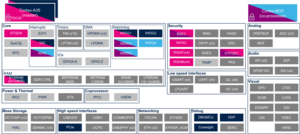Registered User mNo edit summary |
Registered User mNo edit summary |
||
| (2 intermediate revisions by 2 users not shown) | |||
| Line 1: | Line 1: | ||
<noinclude>{{ApplicableFor | <noinclude>{{ApplicableFor | ||
|MPUs list=STM32MP13x, STM32MP15x | |MPUs list=STM32MP13x, STM32MP15x, STM32MP25x | ||
|MPUs checklist=STM32MP13x,STM32MP15x | |MPUs checklist=STM32MP13x,STM32MP15x, STM32MP25x | ||
}}</noinclude> | }}</noinclude> | ||
| Line 24: | Line 24: | ||
===Boot time assignment=== | ===Boot time assignment=== | ||
====On {{MicroprocessorDevice | device=1}}==== | |||
The DDRPERFM peripheral is not used at boot time. | The DDRPERFM peripheral is not used at boot time. | ||
====On {{MicroprocessorDevice | device=2}}==== | |||
{{#lst:STM32MP2_internal_peripherals_assignment_table_template|stm32mp2_a35_boottime}} | |||
<section begin=stm32mp25_a35_boottime /> | |||
| rowspan="1" | Trace & Debug | |||
| rowspan="1" | [[DDRPERFM internal peripheral | DDRPERFM]] | |||
| DDRPERFM | |||
| | |||
| <span title="assignable peripheral but not supported" style="font-size:21px">⬚</span> | |||
| <span title="assignable peripheral but not supported" style="font-size:21px">⬚</span> | |||
| | |||
|- | |||
<section end=stm32mp25_a35_boottime /> | |||
|} | |||
===Runtime assignment=== | ===Runtime assignment=== | ||
| Line 34: | Line 49: | ||
| DDRPERFM | | DDRPERFM | ||
| | | | ||
| <span title=" | | <span title="assignable peripheral" style="font-size:21px">☐</span> | ||
| | | | ||
|- | |- | ||
| Line 47: | Line 62: | ||
| DDRPERFM | | DDRPERFM | ||
| | | | ||
| <span title=" | | <span title="assignable peripheral" style="font-size:21px">☐</span> | ||
| | | | ||
| | | | ||
|- | |- | ||
<section end=stm32mp15_runtime /> | <section end=stm32mp15_runtime /> | ||
|} | |||
====On {{MicroprocessorDevice | device=25}}==== | |||
{{#lst:STM32MP2_internal_peripherals_assignment_table_template|stm32mp25_runtime}} | |||
<section begin=stm32mp25_a35_runtime /> | |||
| rowspan="1" | Trace & Debug | |||
| rowspan="1" | [[DDRPERFM internal peripheral | DDRPERFM]] | |||
| DDRPERFM | |||
| <span title="assignable peripheral but not supported" style="font-size:21px">⬚</span><sup>OP-TEE</sup> | |||
| <span title="assignable peripheral" style="font-size:21px">☐</span> | |||
| <span title="assignable peripheral but not supported" style="font-size:21px">⬚</span> | |||
| <span title="assignable peripheral but not supported" style="font-size:21px">⬚</span> | |||
| | |||
| | |||
|- | |||
<section end=stm32mp25_a35_runtime /> | |||
|} | |} | ||
Latest revision as of 16:57, 8 November 2023
1. Article purpose
The purpose of this article is to:
- briefly introduce the DDRPERFM peripheral and its main features,
- indicate the peripheral instances assignment at boot time and their assignment at runtime (including whether instances can be allocated to secure contexts),
- list the software frameworks and drivers managing the peripheral,
- explain how to configure the peripheral.
2. Peripheral overview
The DDRPERFM peripheral is used to count various DDRCTRL events, for performance analysis.
The read, write and time counters are certainly the ones that are the most useful from user point of view, since they allow computing the DDR read and write throughputs.
Other counters are available in order to monitor the DDR controller arbitration dynamic, refresh commands and low-power management.
Refer to the STM32 MPU reference manuals for the complete list of features, and to the software frameworks and drivers, introduced below, to see which features are implemented.
3. Peripheral usage
This chapter is applicable in the scope of the OpenSTLinux BSP running on the Arm® Cortex®-A processor(s), and the STM32CubeMPU Package running on the Arm® Cortex®-M processor.
3.1. Boot time assignment
3.1.1. On STM32MP1 Series
The DDRPERFM peripheral is not used at boot time.
3.1.2. On STM32MP2 unknown microprocessor device
Click on ![]() to expand or collapse the legend...
to expand or collapse the legend...
| Domain | Peripheral | Boot time allocation | Comment | |||
|---|---|---|---|---|---|---|
| Instance | Cortex-A35 secure (ROM code) |
Cortex-A35 secure (TF-A BL2) |
Cortex-A35 non-secure (U-Boot) | |||
| Trace & Debug | DDRPERFM | DDRPERFM | ⬚ | ⬚ | ||
3.2. Runtime assignment
3.2.1. On STM32MP13x lines 
Click on the right to expand the legend...
| Domain | Peripheral | Runtime allocation | Comment | ||
|---|---|---|---|---|---|
| Instance | Cortex-A7 secure (OP-TEE) |
Cortex-A7 non-secure (Linux) | |||
| Trace & Debug | DDRPERFM | DDRPERFM | ☐ | ||
3.2.2. On STM32MP15x lines 
Click on the right to expand the legend...
| Domain | Peripheral | Runtime allocation | Comment | |||
|---|---|---|---|---|---|---|
| Instance | Cortex-A7 secure (OP-TEE) |
Cortex-A7 non-secure (Linux) |
Cortex-M4 (STM32Cube) | |||
| Trace & Debug | DDRPERFM | DDRPERFM | ☐ | |||
3.2.3. On STM32MP25 unknown microprocessor device
Click on ![]() to expand or collapse the legend...
to expand or collapse the legend...
| Domain | Peripheral | Runtime allocation | Comment | |||||
|---|---|---|---|---|---|---|---|---|
| Instance | Cortex-A35 secure (OP-TEE / TF-A BL31) |
Cortex-A35 non-secure (Linux) |
Cortex-M33 secure (TF-M) |
Cortex-M33 non-secure (STM32Cube) |
Cortex-M0+ (STM32Cube) | |||
| Trace & Debug | DDRPERFM | DDRPERFM | ⬚OP-TEE | ☐ | ⬚ | ⬚ | ||
4. Software frameworks and drivers
Below are listed the software frameworks and drivers managing the DDRPERFM peripheral for the embedded software components listed in the above tables.
- Linux®: perf framework
5. How to assign and configure the peripheral
The peripheral assignment can be done via the STM32CubeMX graphical tool (and manually completed if needed).
This tool also helps to configure the peripheral:
- partial device trees (pin control and clock tree) generation for the OpenSTLinux software components,
- HAL initialization code generation for the STM32CubeMPU Package.
The configuration is applied by the firmware running in the context in which the peripheral is assigned.
6. How to go further
Refer to How to measure the DDR throughput to learn how to use the DDRPERFM internal peripheral via the perf tool.


